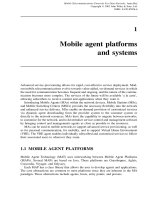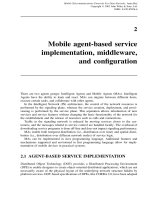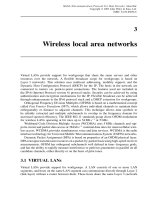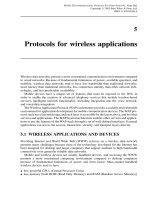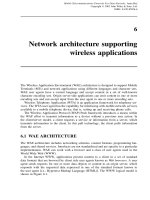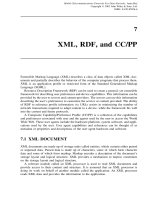Điện thoại di động giao thức viễn thông cho các mạng dữ liệu P8
Bạn đang xem bản rút gọn của tài liệu. Xem và tải ngay bản đầy đủ của tài liệu tại đây (170.76 KB, 24 trang )
8
Architecture of wireless LANs
In a wireless LAN (WLAN), the connection between the client and user exists through the
use of a wireless medium such as Radio Frequency (RF) or Infrared (IR) communications.
This allows the mobile user to stay connected to the network. The wireless connection is
most usually accomplished by the user having a handheld terminal or a laptop computer
that has an RF interface card installed inside the terminal or through the PC Card slot
of the laptop. The client connection from the wired LAN to the user is made through an
Access Point (AP) that can support multiple users simultaneously. The AP can reside at
any node on the wired network and performs as a gateway for wireless users’ data to be
routed onto the wired network.
The range of these systems depends on the actual usage and environment of the system
but varies from 100 ft inside a solid walled building to several 1000 ft outdoors, in direct
Line of Sight (LOS). This is of a similar order of magnitude as the distance that can be
covered by the wired LAN in a building. However, much like a cellular telephone system,
the WLAN is capable of roaming from the AP and reconnecting to the network through
other APs residing at other points on the wired network. This allows the wired LAN to
be extended to cover a much larger area than the existing coverage by the use of multiple
APs, for example, in a university campus environment.
A WLAN can be used independently of a wired network, and it may be used as a stand-
alone network anywhere to link multiple computers without having to build or extend a
wired network. For example, in an outside auditing group in a client company, each
auditor has a laptop equipped with a wireless client adapter. A peer-to-peer workgroup
can be immediately established to transfer or access data. A member of the workgroup
can be established as the server, or the network can perform in a peer-to-peer mode.
A WLAN is capable of operating at speeds in the range of 1, 2, or 11 Mbps, depending
on the actual system. These speeds are supported by the standard for WLAN networks
defined by the international body, the IEEE.
WLANs are billed on the basis of installed equipment cost; however, once in place
there are no charges for the network use. The network communications use a part of
the radio spectrum that is designated as license-free. In this band, of 2.4 to 2.5 GHz, the
Mobile Telecommunications Protocols For Data Networks. Anna Ha
´
c
Copyright
2003 John Wiley & Sons, Ltd.
ISBN: 0-470-85056-6
140
ARCHITECTURE OF WIRELESS LANs
users can operate without a license when they use equipment that has been approved for
use in this license-free band. In the United States, this license is granted by the Federal
Communications Commission (FCC) for operation under Part 15 regulations. The 2.4-
GHz band has been designated as license-free by the International Telecommunications
Union (ITU) and is available for use, license-free in most countries in the world. The
rules of operation are different in almost every country but they are similar enough so
that the products can be programmed for use in every country without changing the
hardware component.
The ability to build a dynamically scalable network is critical to the viability of a
WLAN, as it will inevitably be used in this mode. The interference rejection of each node
will be the limiting factor to the expandability of the network and its user density in a
given environment.
8.1 RADIO FREQUENCY SYSTEMS
Radio Frequency (RF) and Infrared (IR) are the main technologies used for wireless
communications. RF and IR technologies are used for different applications and have
been designed into products that optimize the particular features of advantage.
RF is very capable of being used for applications in which communications are not
line of sight and are over longer distances. The RF signals travel through walls and
communicate where there is no direct path between the terminals. In order to operate
in the license-free portion of the spectrum called the Industrial, Scientific, and Medical
(ISM) band, the radio system must use a modulation technique called Spread Spectrum
(SS). In this mode a radio is required to distribute the signal across the entire spectrum
and cannot remain stable on a single frequency. No single user can dominate the band, and
collectively all users look like noise. Spread Spectrum communications were developed to
be used for secure communication links. The fact that such signals appear to be noise in
the band means that they are difficult to find and to jam. This technique operates well in
a real WLAN application in this band and is difficult to intercept, thus increasing security
against unauthorized listeners.
The use of Spread Spectrum is especially important as it allows many more users
to occupy the band at any given time and place than if they were all static on separate
frequencies. With any radio system, one of the greatest limitations is available bandwidth,
and so the ability to have many users operate simultaneously in a given environment is
critical for the successful deployment of WLAN.
There are several bands available for use by license-free transmitters; the most com-
monly used are at 902 to 928 MHz, 2.4 to 2.5 GHz, and 5.7 to 5.8 GHz. Of these, the most
useful is probably the 2.4-GHz band as it is available for use throughout most parts of the
world. In recent years, nearly all the commercial development and the basis for the new
IEEE standard has been in the 2.4-GHz band. While the 900-MHz band is widely used for
other systems, it is only available in the United States and has greatly limited bandwidth
available. In the license-free bands, there is a strict limit on the broadcast power of any
transmitter so that the spectrum can be reused at a short distance away without interference
from a distant transmitter. This is similar to the operation of a cellular telephone system.
SPREAD SPECTRUM IMPLEMENTATION
141
8.2 INFRARED SYSTEMS
Another technology that is used for WLAN systems is Infrared, in which the communica-
tion is carried by light in the invisible part of the spectrum. This system is primarily of use
for very short distance communications, less than 3 ft where there is a LOS connection.
It is not possible for the IR light to penetrate any solid material; it is even attenuated
greatly by window glass, so it is really not a useful technology in comparison to Radio
Frequency for use in a WLAN system.
The application of Infrared is as a docking function and in applications in which the
power available is extremely limited, such as a pager or PDA. The standard for such
products is called Infrared Data Association (IrDA), which has been used by Hewlett
Packard, IBM, and others. This is found in many notebook and laptop PCs and allows
a connectionless docking facility up to 1 Mbps to a desktop machine up to two feet line
of sight.
Such products are point-to-point communications and offer increased security, as only
the user to whom the beam is directed can pick it up. Attempts to provide wider network
capability by using a diffused IR system in which the light is distributed in all directions
have been developed and marketed, but they are limited to 30 to 50 ft and cannot go
through any solid material. There are very few companies pursuing this implementation.
The main advantage of the point-to-point IR system – increased security – is undermined
here by the distribution of the light source as it can now be received by anybody within
range, not just the intended recipient.
8.3 SPREAD SPECTRUM IMPLEMENTATION
There are two methods of Spread Spectrum modulation that are used to comply with
the regulations for use in the ISM band: Direct Sequence Spread Spectrum (DSSS), and
Frequency Hopping Spread Spectrum (FHSS).
8.3.1 Direct sequence spread spectrum
Historically, many of the original systems available used DSSS as the required spread
spectrum modulation because components and systems were available from the Direct
Broadcast Satellite industry, in which DSSS is the modulation scheme used. However,
the majority of commercial investments in WLAN systems are now in FHSS and the user
base of FHSS products will exceed that of DSSS. Most of the new WLAN applications
will be in FHSS.
A DSSS system takes a signal at a given frequency and spreads it across a band of
frequencies where the center frequency is the original signal. The spreading algorithm,
which is the key to the relationship of the spread range of frequencies, changes with
time in a pseudorandom sequence that appears to make the spread signal a random noise
source. The strength of this system is that when the ratio between the original signal
bandwidth and the spread signal bandwidth is very large, the system offers great immunity
to interference. For instance, if a 1-Kbps signal is spread across 1 GHz of spectrum, the
142
ARCHITECTURE OF WIRELESS LANs
spreading ratio is one million times or 60 dB. This is the type of system developed for
strategic military communications systems as it is very difficult to find and is even more
difficult to jam.
However, in an environment such as WLAN in the license-free, ISM band, in which
the available bandwidth critically limits the ratio of spreading, the advantages that the
DSSS method provides against interference become greatly limited. A realistic example
in use today is a 2-Mbps data signal that is spread across 20 MHz of spectrum and that
offers a spreading ratio of 10 times. This is only just enough to meet the lower limit
of processing gain, a measure of this spreading ratio, as set by the FCC, the United
States government body that determines the rule of operation of radio transmitters. This
limitation significantly undermines the value of DSSS as a method to resist interference
in real WLAN applications.
8.3.2 Frequency hopping spread spectrum
FHSS is based on the use of a signal at a given frequency that is constant for a small
amount of time and then moves to a new frequency. The sequence of different channels
determined for the hopping pattern, that is, where the next frequency will be to engage
with this signal source, is pseudorandom. Pseudo means that a very long sequence code is
used before it is repeated, over 65 000 hops, making it appear to be random. This makes it
very difficult to predict the next frequency at which such a system will stop and transmit
or receive data, as the system appears to be a random noise source to an unauthorized
listener. This makes the FHSS system very secure against interference and interception. In
an FHSS system at a data rate of 1 Mbps or higher, even a fraction of a second provides
significant overall throughput for the communications system.
This system is a very robust method of communicating as it is statistically close to
impossible to block all the frequencies that can be used and as there is no spreading
ratio requirement that is so critical for DSSS systems. The resistance to interference is
determined by the capability of the hardware filters that are used to reject signals other
than the frequency of interest, and not by mathematical spreading algorithms. In the case
of a standard FHSS WLAN system, with a two-stage receive section, the filtering will be
provided in excess of 100 000 times rejection of unwanted signals, or over 50 dB.
8.3.3 WLAN industry standard
Industry standards are critical in the computer business and its related industries. They
are the vehicles that provide a large enough market to be realistically defined and targeted
with a single, compatible technological solution that many manufacturers can develop.
This process reduces the cost of the products to implement the standard, which further
expands the market.
In 1990, the IEEE 802 standards groups for networking set up a specific group to
develop a WLAN standard similar to the Ethernet standard. In 1997, the IEEE 802.11
WLAN Standard Committee approved the IEEE 802.11 specification. This is critical for
the industry as it now provides a solid specification for the vendors to target, both for sys-
tems products and components. There are three sections of the specification representing
FHSS, DSSS, and IR physical layers.
IEEE 802.11 WLAN ARCHITECTURE
143
The standard is a detailed software, hardware, and protocol specification with regard to
the physical and data link layer of the Open System Interconnection (OSI) reference model
that integrates with existing wired LAN standards for a seamless roaming environment. It
is specific to the 2.4-GHz band and defines two levels of modulation that provide a basic
1-Mbps and enhanced 2-Mbps system.
The implications of an agreed standard are very significant and are the starting point
for the WLAN industry in terms of a broader market. To this point, the market has been
dominated by implementations that are custom developments using a specific manufac-
turers proprietary protocol and system. The next generation of these products for office
systems will be based on the final rectified standard.
The WLAN systems discussed and those specified by the IEEE 802.11 standard operate
in the unlicensed spectrum. The unlicensed spectrum allows a manufacturer to develop a
piece of equipment that operates to meet predefined rules and for any user to operate the
equipment without a requirement for a specific user license. This requires the manufacturer
to make products that conform to the regulations for each country of operation and they
should also conform to the IEEE 802.11 standard.
While the 2.4-GHz band is available in most countries, each country’s regulatory
bodies have usually set requirements that are different in detail. There are three major
specification groups that set the trend that most other countries follow. The FCC sets
a standard covered by the Part 15 regulations that are used in much of the rest of the
United States and the world. The Japanese Nippon Telegraph and Telephone (NTT) has
its own standard. The European countries have set a specification through European
Telecommunications Standards Institute (ETSI).
While all these differ in detail, it is possible to make a single hardware product that is
capable of meeting all three specifications with only changes to the operating software.
Although the software could be downloaded from a host such as a notebook PC, the
changes are required to be set by the manufacturer and not the user in order to meet the
rules of operation.
The increasing demand for network access while mobile will continue to drive the
demand for WLAN systems. The Frequency Hopping technology has the ability to support
significant user density successfully, so there is no limitation to the penetration of such
products in the user community. WLAN solutions will be especially viable in new markets
such as the Small Office/Home Office (SOHO) market, where there is rarely a wired LAN
owing to the complexity and cost of wiring. WLAN offers a solution that will connect a
generation to wired access, but without using the wires.
8.4 IEEE 802.11 WLAN ARCHITECTURE
In IEEE 802.11 the addressable unit is a station (STA), which is a message destination, but
not (in general) a fixed location. IEEE 802.11 handles both mobile and portable stations.
Mobile Stations (MSs) access the LAN while in motion, whereas a Portable Station (PS)
can be moved between locations, but it is used only at a fixed location. MSs are often
battery powered, and power management is an important consideration since we cannot
assume that a station’s receiver will always be powered on.
144
ARCHITECTURE OF WIRELESS LANs
IEEE 802.11 appears to higher layers [logical link control (LLC)] as an IEEE 802
LAN, which requires that the IEEE 802.11 network handles station mobility within the
Medium Access Control (MAC) sublayer, and meets the reliability assumptions that LLC
makes about the lower layers.
The IEEE 802.11 architecture provides a WLAN supporting station mobility transpar-
ently to upper layers. The Basic Service Set (BSS) is the basic building block consisting
of member stations remaining in communication. If a station moves out of its BSS, it can
no longer directly communicate with other members of the BSS.
The Independent BSS (IBSS) is the most basic type of IEEE 802.11 LAN and may
consist of at least two stations that can communicate directly. This LAN is formed only
as long as it is needed and is often referred to as an ad hoc network. The association
between an STA and a BSS is dynamic, since STAs turn on and off, come within range
and go out of range.
A BSS may form the Distribution System (DS), which is an architectural component
used to interconnect BSSs. IEEE 802.11 logically separates the Wireless Medium (WM)
from the Distribution System Medium (DSM). Each logical medium is used for different
purposes by a different component of the architecture. The IEEE 802.11 LAN architecture
is specified independently of the physical characteristics of any specific implementation.
The DS enables mobile device support by providing the logical services necessary to
handle address-to-destination mapping and seamless integration of multiple BSSs. An
Access Point (AP) is an STA that provides access to the DS by providing DS ser-
vices in addition to acting as an STA. The data move between a BSS and the DS
via an AP. All APs are also STAs, and they are addressable entities. The addresses
used by an AP for communication on the WM and on the DSM are not necessarily
the same.
The DS and BSSs allow IEEE 802.11 to create a wireless network of arbitrary size
and complexity called Extended Service Set (ESS) network. The ESS network appears the
same to an LLC layer as an IBSS network. Stations within an ESS may communicate and
MSs may move from one BSS to another (within the same ESS), transparently to LLC.
A portal is the logical point at which MAC Service Data Units (MSDUs) from an
integrated non-IEEE 802.11 LAN enter the IEEE 802.11 DS. All data from non-IEEE
802.11 LANs enter the IEEE 802.11 architecture via a portal, which provides logical
integration between the IEEE 802.11 architecture and existing wired LANs. A device may
offer both the functions of an AP and a portal, for example, when a DS is implemented
from IEEE 802 LAN components.
Architectural services of IEEE 802.11 are as follows: authentication, association, deau-
thentication, disassociation, distribution, integration, privacy, reassociation, and MSDU
delivery. These services are provided either by stations as the Station Service (SS) or by
the DS as the Distribution System Service (DSS).
The SS includes authentication, deauthentication, privacy, and MSDU delivery. The
SS is present in every IEEE 802.11 station, including APs, and is specified for use by
MAC sublayer entities.
The DSSs include association, disassociation, distribution, integration, and reassociation.
TheDSSsareprovidedbytheDSandareaccessedbyanAP,whichisanSTAthatalso
provides DSSs. DSSs are specified for use by MAC sublayer entities.
IEEE 802.11 WLAN ARCHITECTURE
145
The IEEE 802.11 architecture handles multiple logical media and address spaces and is
independent of the DS implementation. This architecture interfaces cleanly with network
layer mobility approaches.
8.4.1 IEEE 802.11a and IEEE 802.11b
IEEE 802.11a is an extension to 802.11 that applies to WLANs and provides up to 54 Mbps
in the 5-GHz band. IEEE 802.11a uses an Orthogonal Frequency Division Multiplexing
(OFDM) encoding scheme rather than FHSS or DSSS.
The IEEE 802.11a standard is designed to operate in the 5-GHz Unlicensed National
Information Infrastructure (UNII) band. Specifically, the FCC has allocated 300 MHz of
spectrum for unlicensed operation in the 5-GHz block, 200 MHz of which is at 5.15 to
5.35 MHz, with the other 100 MHz at 5.725 to 5.825 MHz. The spectrum is split into three
working domains. The first 100 MHz in the lower section is restricted to a maximum power
output of 50 mW (milliwatts). The second 100 MHz has 250-mW power output, and the
top 100 MHz is used for outdoor applications with a maximum of 1 watt power output.
IEEE 802.11b, also referred to as 802.11 High Rate or Wi-Fi (Wireless Fidelity), is
an extension to 802.11 that applies to WLANs and provides 11-Mbps transmission (with
a fallback to 5.5, 2, and 1 Mbps) in the 2.4-GHz band. IEEE 802.11b uses only DSSS.
IEEE 802.11b was a 1999 ratification to the original 802.11 standard, allowing wireless
functionality comparable to Ethernet.
The IEEE 802.11b specification allows for the wireless transmission of approximately
11 Mbps of data at distances from several dozen to several 100 ft over the 2.4-GHz (2.4 to
2.483) unlicensed RF band. The distance depends on impediments, materials, and LOS.
IEEE 802.11b standard defines two bottom levels of OSI reference model – the Phys-
ical Layer (PHY) and the Data Link Layer (MAC sublayer).
IEEE 802.11b defines two pieces of equipment, a wireless station, which is usually a
PC or a Laptop with a wireless Network Interface Card (NIC), and an Access Point (AP),
which acts as a bridge between the wireless stations and Distribution System or wired
networks. There are two operation modes in IEEE 802.11b, Infrastructure Mode and Ad
Hoc Mode.
Infrastructure Mode consists of at least one AP connected to the Distribution System.
An AP provides a local bridge function for the BSS. All wireless stations communicate
with the AP and no longer communicate directly. All frames are relayed between wireless
stations by the AP.
An ESS is a set of infrastructure BSSs, in which the APs communicate amongst
themselves to forward traffic from one BSS to another to facilitate movement of wireless
stations between BSSs.
The wireless stations communicate directly with each other. Every station may not be
able to communicate with every other station because of the range limitations. There are
no APs in an IBSS. Therefore all stations need to be within range of each other and they
communicate directly.
IEEE 802.11b defines dynamic rate shifting, allowing data rates to be automatically
adjusted for noisy conditions. This means IEEE 802.11b devices will transmit at lower
speeds, 5.5 Mbps, 2 Mbps, and 1 Mps under noisy conditions. When the devices move
146
ARCHITECTURE OF WIRELESS LANs
back within range of a higher speed transmission, the connection will automatically speed
up again.
8.5 BLUETOOTH
Bluetooth devices operate at 2.4 GHz in the ISM band. The operating band of 83.5 MHz
is divided into 1-MHz channels, each signaling data at 1 M Symbols per second to obtain
1Mbs
−1
available channel bandwidth by using Gaussian Frequency Shift Keying (GFSK).
Bluetooth devices use FHSS, and each time slot lasts 625 µs. The radio power ranges for
Bluetooth applications are 10 m, 20 m, and 100 m, for different power classes.
Bluetooth devices operate in two modes, as a master or as a slave. The master sets the
frequency hopping sequence, and the slaves synchronize to the master in time and fre-
quency. Every Bluetooth device has a unique address and clock. All slaves use the master
address and clock and are synchronized to the master’s frequency hop sequence. Each
Bluetooth device may be either a master or a slave at any time, but not simultaneously.
A master initiates an exchange of data and a slave responds to the master.
The master controls when devices are allowed to transmit. The master allows slaves to
transmit by allocating slots for data traffic or voice traffic. In data traffic slots, the slaves
are only allowed to transmit when replying to a transmission to them by the master. In
voice traffic slots, slaves are required to transmit regularly in reserved slots whether or
not they are replying to the master. The master uses Time Division Multiplexing (TDM)
to allocate time slots to the slaves depending on the data-transfer requirements.
A number of slave devices operating together with one master create a piconet in which
all devices follow the frequency hopping sequence and timing of the master. The slaves
in a piconet only have links to the master; there are no direct links between slaves. A
point-to-point connection occurs with one slave and a master, and a point-to-multipoint
connection exists with one master and up to seven slaves in a piconet.
Piconets can be linked into a scatternet, in which some devices are members of more
than one piconet. These devices must time-share, spending a few slots on each piconet.
Different devices are the masters in different piconets, and a scatternet cannot share
amaster.
Bluetooth devices sharing a piconet are synchronized to avoid collision, but the devices
in other piconets are not synchronized and may randomly collide on the same frequency.
The packets lost because of collision will be retransmitted and voice packets will be
ignored. The number of collisions and retransmissions increases with the growing number
of piconets and scatternets.
Three power classes allow Bluetooth devices to connect at different ranges: Class 1
uses 100 mW (20 dBm), Class 2 uses 2.5 mW (4 dBm), Class 3 uses 1 mW (0 dBm). The
maximum ranges for Classes 1, 2, and 3, are 100 m, 20 m, and 10 m, respectively.
Bluetooth devices use Asynchronous Connectionless (ACL) links for data communi-
cation and Synchronous Connection Oriented (SCO) links for voice communication.
The ACL link provides a packet-switched connection in which data is exchanged
sporadically as and when data is available. The master decides, on a slot-by-slot basis,
as to which slave to transmit, or from which slave to receive information. This way both
BLUETOOTH
147
asynchronous and isochronous (time-bounded) services are possible. Most ACL packets
facilitate error checking and retransmission to assure data integrity. If a slave is addressed
in a master to slave slot, this slave may only respond with an ACL packet in the next
slave to master slot. If the slave fails to decode the slave address in the packet header, or it
is not sure whether it was addressed, then it is not allowed to respond. Broadcast packets
are ACL packets not addressed to a specific slave and are received by every slave.
The SCO link provides a circuit-switched connection between master and slave. A
master can support up to three SCO links to the same slave or to different slaves. A
slave can support up to three SCO links from the same master. Because of the delay-
bounded nature of SCO data, SCO packets are never retransmitted. The master will
transmit SCO packets to the slave at regular intervals, counted in slots. The slave is
allowed to respond with an SCO packet in the reserved response slot, unless it correctly
decoded the packet header and discovered that it had not been addressed as expected. If
the packet was incorrectly decoded because of errors, then the slave may still respond as
the slot is reserved and the master is not allowed to transmit elsewhere in the reserved
slot. An exception is a broadcast Link Management Protocol (LMP) message, which takes
precedence over the SCO link.
A Bluetooth packet consists of an access code, a header, and a payload. The access
code is used to detect the presence of a packet and to address the packet to a specific
device. For example, slaves detect the presence of a packet by matching the access code
against their stored copy of the master’s access code. The header contains the control
information associated with the packet and the link, such as the address of the slave to
which the packet is sent. The payload contains the actual message information, if this is
a higher layer protocol message, or the data, if this is data being passed down the stack.
The following four access codes are used by Bluetooth:
• Channel Access Code (CAC) derived from the master’s Lower Address Part (LAP) and
used by all devices in a piconet during the exchange of data over a live connection.
• Device Access Code (DAC) derived from a specific device’s LAP. DAC is used when
paging a specific device and by that device in Page Scan while listening for paging
messages to itself.
• General Inquiry Access Code (GIAC) used by all devices during the inquiry procedures,
since no prior knowledge of anyone’s LAP exists.
• Dedicated Inquiry Access Code (DIAC) is a specified range of inquiry access code
(IAC) reserved to carry inquiry procedures between specific sets of devices like printers
or cellular handsets.
8.5.1 Bluetooth architecture
The Bluetooth protocol stack is shown in Figure 8.1 opposite the Open Systems Inter-
connect (OSI) standard reference model. The physical layer covers the radio and part of
the baseband and is responsible for the electrical interface to the communications media,
including modulation and channel coding. The data link layer covers the control end of
the baseband, including error checking and corrections and overlaps the link controller

